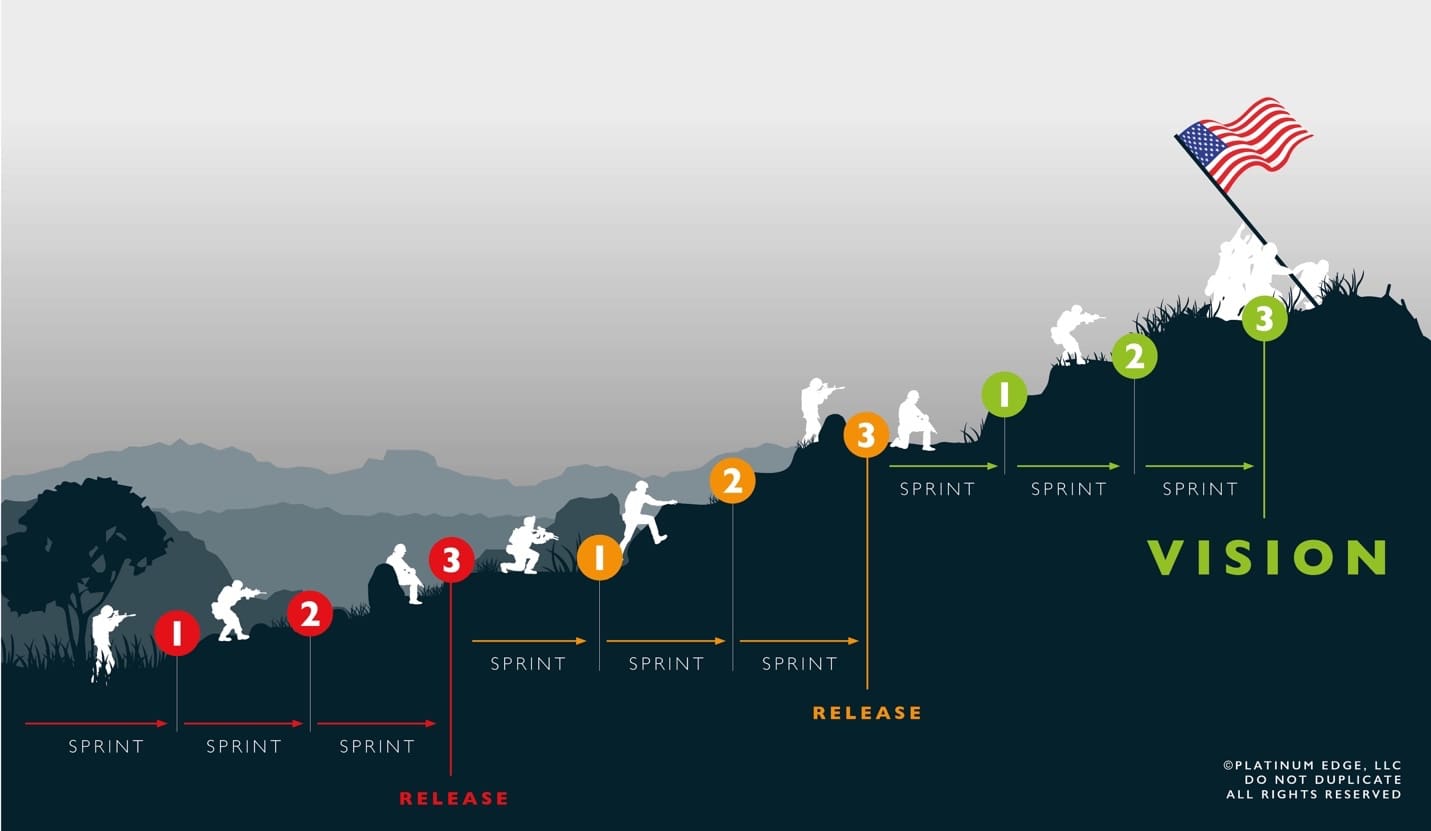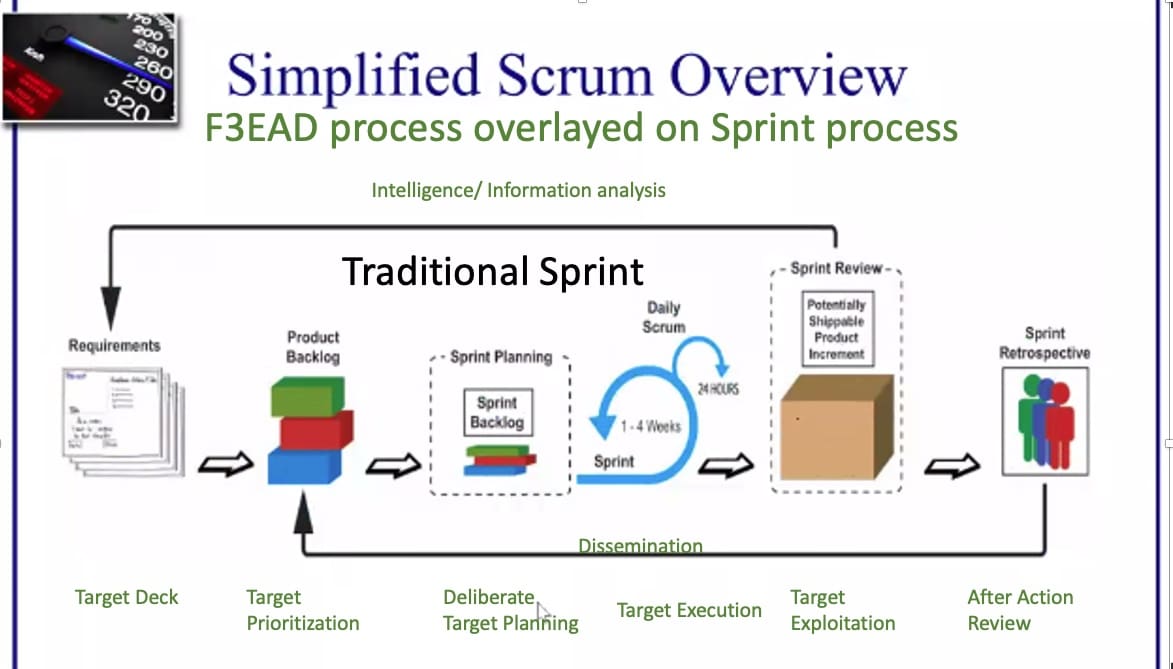Military leaders are asking their components to become more agile.
What does that mean? To be agile means adopting and accepting the agile principles, moving away from a top-down hierarchy filled with bureaucracy and individual silos, Agile promotes a ‘guiding’ leadership model surrounded by teams that are flexible and accountable.
Where did Agile come from? Agile was born out of necessity in software engineering to provide faster updates and build upon user feedback. Prior to the modern agile movement, development teams would identify the problem, create a solution, develop a product, then bring it to market, all without extensively engaging the customer. This is known as the ‘waterfall approach’. This method has proven to be slow, cumbersome, and often times, brings a product to market which does not meet the true need of the customer. In early 2000, software developers met to discuss their challenges, and later in 2001, developed what is known today as the ‘Agile Manifesto’. The key values of which being: people over process, working product over comprehensive documentation, end user collaboration over contracts, and responding to change over following a plan. Agile is now in use by every Fortune 500 company and is utilized by more than 97% of mid-market commercial companies worldwide. Adopters of Platinum Edge’s suite of services have enjoyed a 30-40% increase in time to market with a cost savings from 30-70%. Although the original idea was for use in the technology world, the values and principles remain true for any type of program management.
The U.S. military has a long history of being the focal point of excellence when it comes to planning and execution. Utilizing the JOPES and MDMP process is a long-proven method of planning and conducting military operations. As the Military shifts to a more business-like model, there is a need to adopt the proven agile approaches to accomplish our goals.

So, how and where does the Military adopt Agile? Like many businesses and organizations, the Military has to be open to change, both in culture and structure. In military planning, there is a hierarchy and clear chain of command. With Agile however, you must allow for the team to take ownership while leaders should act as a guide. Think in the terms of staff functions from company level, to corps, and above. The staff directorates from your S-1’s, G-2’s, J-3’s, etc., work within the confines of their ‘stove pipes’ and report to a Chief of Staff or Commander on individual efforts. In an organization using Agile, you create cross-functional teams based on products. These teams are developed based on the talent needed to complete the end product, not just with whoever is available, i.e. ‘people over process’. This lightweight team concentrates on a goal while incrementally chopping away at the deliverables. The team holds each other accountable along the way and communicates as much as possible in order to facilitate success. This model allows for self-correction and keeps the ‘customer’ involved along the way.

How does an individual, a team, a unit become more Agile? To become agile is not just a declaration or a command. To be agile means a formal adoption of principles while putting faith in the system and processes. Training is available from the basics of agile, Certified Scrum Masters of multiple levels, as well as coaching, mentoring, objective audits, and more. Each of the courses are credentialed, and are free to the soldier via IgnitED (the Army’s new Credentialing Assistance platform). Being credentialed in agile frameworks provide opportunities for future employment as well as tools for the current scope of work. Companies like Platinum Edge provide these opportunities both virtually as well as in-person and can scale to meet the need of the individual, the team, or the unit.

SCRUM, it’s not a rugby maneuver… so, what is it? scrum is a transparency framework that helps us identify what is working in reality. It is a self-correcting model in which, even if you are wrong in the beginning, you can be right in the end because scrum gives you multiple opportunities to correct course toward the target. Tactically flexible yet strategically focused, your next move changes but your target is stable. It is also a structured learning cycle that allows you to adapt and change based off of experience. At the core of a scrum is the ‘sprint’. A sprint is the activity that drives the process. The sprint is a time-determined activity in which the major product development tasks are completed. At the end of the sprint, the scrum team conducts a ‘retrospective’ to determine what worked, what didn’t, what can move forward, and what can wait. Every level of a military unit can utilize the scrum framework, whether it’s project management, or conducting operations. It is flexible and adaptable to all situations. Many military leaders are familiar with the F3EAD process, scrum is similar however it does take training to practice scrum correctly. Having a coach or a Certified Scrum Master ensures you are playing correctly.
How does being a ‘Certified Scrum Master’ (CSM) help me?
The Scrum Master is a member of the scrum team, who is charged with making sure everyone on the team is playing scrum correctly. Think of them as a referee in a sport; an objective outside influencer that ensures the game is played correctly. The Scrum Master is a majorly critical piece in the scrum team, and the position is not to be taken lightly nor ignored. If the military is to adopt agile, identification of the right talent and promoting this position is of the utmost importance. By choosing to be a Scrum Master, you are joining a small community of individuals whose expertise can be utilized no matter the type of work. To be an objective outsider means you can walk into any type of business or organization and play scrum, no matter the type of product. As a CSM, you can move easily throughout any organization providing great value, both in the military, and post-career in any one of the 40,000 businesses currently seeking CSMs (most positions offer $100,000/ year).
How can I become a ‘Certified Scrum Master’? Becoming a CSM is easy. Platinum Edge has a 2-day (in-person) or 4-day (virtual) Certified Scrum Master course, during which you will learn the basics of being a CSM. Similar to gaining rank in the military, there are multiple levels of a CSM and you must meet certain training and experience quotas prior to advancing. The more you advance, the better you are, and the more valuable an asset you are to the team. Credentialing Assistance allows for a service member to obtain their CSM credentials as well as follow on courses. Each service member (Enlisted/Warrant) is allowed $4000.00 per year in assistance, which is more than enough to obtain their CSM, as well as propel through the levels during their career. As of August 15th, the Army has transitioned to IgnitED for all credentialing opportunities.
What else should I know? Before you dive in, I encourage you to discover more about Agile and SCRUM. The first recommended read is the Agile Manifesto. This lays out the reasoning and principles of agile and is the basis for all agile techniques. Next, the Scrum Guide, gives you an overview of the terms, definitions, positions, and events of SCRUM. The Agile Method on LinchpinSEO is a great article on traditional vs. Agile approach. You can also get deep into the weeds with the SCRUM for Dummies guide, written by Mark Layton.

Why Platinum Edge? I have mentioned Platinum Edge and Mark Layton throughout this article and for good reason. Mark is the founder of Platinum Edge and is the world’s foremost expert on transforming organizations to the agile methodology. Mark, a veteran of the US Air Force, also holds a secret security clearance and is a published author on the subject of scrum and agile. The 1st Special Warfare Training Group at the US Army Special Warfare Center and School has placed their trust in Platinum Edge to provide CSM training to their instructor corps for individual professional development, as well as to begin their change in culture. If you are an instructor at SWCS or assigned to USASOC at Fort Bragg, reach out to 1st SWTG (Project JANUS) to learn more about your training opportunities. For all others interested in obtaining credentials or information on credentialing assistance, visit your local Education center. As for everyone else, feel free to contact Platinum Edge for more information.
Tom Kerr, a retired Special Forces NCO who attended the Certified Scrum Master Course during his transition from service and now utilizes the agile methodology and practices scrum in his daily program management duties at the Strategic Advisory “Firm”, Armor Corps.


So…mission command (aka auftragstaktik) or ‘spiral development’ (re: technology development) with a cool new wrapper?
“Cool new wrapper.” Indeed.
While this article is not all inclusive, you need to attend a class to realize the full benefit and scope of scrum. Yes, there are many similarities in different development processes, but companies becoming agile, utilizing scrum is the new standard.
This is actually neat. I’ve been involved with this at my Civilian Job. More and more companies are adapting Agile methods to cope with the ever changing demands. We work in weekly sprints to accomplish out development tasks.
It’s actual quite interesting to see the military adopting this. I can envision this at the team/squad level with the TL or SL being the scrum master. This will free the individual soldier up to “self determine” the best course of action. Of course this requires competent soldiers but removing rigid hierarchy speeds up processes.
Chris I like your insight. When I learned Scrum I saw how it can fit in so many applications within the daily grind of a G level Shop. In fact if I could create cross functional teams Across the staff I’m sure we can become way more efficient.
The other part of Scrum that I really like is it does require everyone in the sprint to participate, there is accountability built in.
Cool. But my principal reservation on this, and most of the other management trends which come along every several years, is this: The lamentably uneven distribution of human talent. My 10/80/10 theory is that 80% of people are, by dint of temperament, life-training, and brainpower/IQ, simply along for the ride. 10% are the leaders/positive influencers/implementers (with 1% of these being the actual original thinkers). The bottom 10% are essentially useless or actually deleterious to the stuatus quo, let alone any form of progress.
This may not be quite so evident the further one escapes (by service in highly selective units/organizations) from the dismal grey of the average human condition, but there it is.
My point is that most military structures and processes are designed (inherited?), after painful and bloody lessons, to be simple and repeatable and suitable to be at least half-ass trained to conscripts and non-professionals, and executable under the stress of war. The wunder-management trends can offer some great stuff, but I question whether they can be executed/sustained without an inordinate allocation of intense leadership and the diversion of the best (that 10%) and very best (1%) of our talent.
I hope I’m missing something – what is it?
I just survived almost 3 years of what you described.
I saw compete half-wit morons get promoted while solid guys were passed.
All about who could scream louder and toss someone under the bus before they themselves would be tossed under the bus.
HOOAH.
Junior, did you just complete a tour in USAREC (US Army Recruiting Command), perchance?
Certain industries (IT, for example) are using this methodology for some time already with some curious effects. Usually, management that decides to pay a consulting company for deploying this stuff treats it as a magical ritual that must improve everything automatically. Obviously, it doesn’t, in this kind of case. Basically, it creates a cargo cult that is paid (pretty large sum of money) for, so it’s neither improves anything nor goes away since nobody has a courage to say “scrap this bullshit, let’s either ditch it or do it right”. Yes, there are the “safeguards” against the cargo cult built into the methodology, but that’s the first thing that’s getting ditched once applied formally. Don’t get me wrong, some consulting companies are more honest than others, not all of them are snakeoil salesmen. But it takes two parties to get everything right and it’s rare, unfortunately. The bottom line is that if (almost) everything already works great it could help to make it better, if it’s far from that, it will likely make everything worse.
As the first commenter says, this is nonsense. Agile was inspired by things such as Auftragstaktik (a.k.a Mission Command) and John Boyd’s OODA loop. And the ‘article’ is basically an ad for scrum master training.
The best thing to look at in this space are things like McChrystal’s ‘Team of Teams’ and ‘One Mission’ and Mattis’ ‘Call Sign Chaos’. They describe military agility in ways that have been used to inspire agility in the software space.
Also ‘Turn the Ship Around’ by L David Marquet, something of an agile bible that tells the story of leadership on a submarine…
Well then, you know how to do it all. And yes, that is some serious sarcasm. You might, but the military doesn’t.
With the exception of a few organizations who remain engaged, the military no longer moves at the speed of war. Despite Herculean efforts at the top to adapt, the small unit continues to do business just like it did before the war started and probably worse because all of the institutionally knowledge is long gone.
We can’t get guys to read Boyd and if you asked the average service member what Auftragstaktik was they’d fail at even repeating the phrase to you let alone explain it.
So, if you can get some hard chargers to learn a new way of doing things, that is based on sound principles, do it.
Ouch! But probably deserved, I did comment in a bit of a rush.
Here’s the thing. My job is helping software teams adopt agile. Agile has been a thing in IT for more than 30 years, even if its only really been the last 10-15 or so that it has become mainstream. Its a ‘solved problem’ in IT. We know what good agile looks like, we have examples of all the right behaviours, practices, tools, etc. for the past few years backed by solid research.
Despite that its still achingly hard to get to get teams across it and change how they’ve done things in many cases for years. And this is in the home ground of agile where all of the training has been refined over years for that specific domain. If we were just dealing with computers we could ‘install’ agile in 5 mins and be done. But we’re dealing with humans. And humans relate best to stuff that they know and that makes sense in their context.
There are so many amazing examples of agility in a military context that I think would land much better, and its worth acknowledging that agility has stolen a lot from the military. The stuff in Team of Teams is Agile, no question, And its been proven in your domain. Same for Mattis, I wish I could get my teams to role play stuff out in planning like they did. Then you’ve got some of the cool stuff the Marines are doing with 3d printing and rapid development…
And the lat thing, Agile is bloody hard work and the team needs to want to do it, do the graft, be brutally honest about issues and fix them. I see lots of people vote themselves off the island because they don’t want to do that. But if you don’t have that desire to improve all Agile or Scrum is going to do is make it transparent that things are broken. It won’t fix them.
Most of DoD’s problems exist because no one wants to even identify them, let alone consider solutions. Institutional momentum is a MoFo.
Pageantry is the enemy of Agility. The military is near wholly pageantry-ridden. Problem: most service members aren’t creative enough to see the parallels in Scrum and their operational doctrine, or rather, how to apply it. Would require all hands to value efficiency over pride and it may be a sour pill, but this training en masse would be invaluable to the team concept and the entirety of the services. It places objective over credit. That’s the true definition of service.
I think you hit the nail on the head. I’ve seen this in my civilian job while trying to move into the agile world. A main aim/goal of the agile world is to put aside “Caste Structure” and prioritize work by output. Some folks are always are tied to “this is my job” mentality so if the task is not in their lane they don’t work it. This breaks the efficiency model and create disturbance in the sprint. Once individuals place their pride/position/title aside and work as a unified team then the efficiency starts taking place. The idea of the “next up” becomes reality (i.e. task in goes to first available).
I think you hit the nail on the head. I’ve seen this in my civilian job while trying to move into the agile world. A main aim/goal of the agile world is to put aside “Caste Structure” and prioritize work by output. Some folks are always are tied to “this is my job” mentality so if the task is not in their lane they don’t work it. This breaks the efficiency model and create disturbance in the sprint. Once individuals place their pride/position/title aside and work as a unified team then the efficiency starts taking place. The idea of the “next up” becomes reality (i.e. task in goes to first available).
FWIW, we’ve been using Agile for over a year now. To be honest, I haven’t seen much benefit over Waterfall. Using Waterfall, we would deliver about 4-5 software releases per year. Under Agile, we’ve only delivered 3. And our velocity and capacity have been maxed out.
Part of the problem is that we have to rely on outside agencies and groups that are not Agile and don’t have to be Agile. We are constrained by them.
I’ve also noticed that is is much harder under Agile to get your required training for your certifications in. Now, our folks are always working on something. Under Waterfall, you had some down time during testing that you could use to take care of training, take vacation, etc. When I brought that up to management, and recommended we setup a monthly down day for training, I was told that its your responsibility to take your training when you can. Gee, thanks.
Also, I’m concerned about burn out. Under Waterfall, each group had some time where things weren’t busy so you could catch your breath. You don’t have that under Agile. You can’t keep a high operational tempo going for long without folks starting to suffer, and then punching out to take other jobs.
At least for my organization, i’m not sure that Agile is going to be the big “cure all” that is has been touted to be. IMHO, it would have been better to study each organization that isn’t producing and find out what the cause is. My personal belief is that it is due to bad management and bad leadership. Agile won’t solve that…..